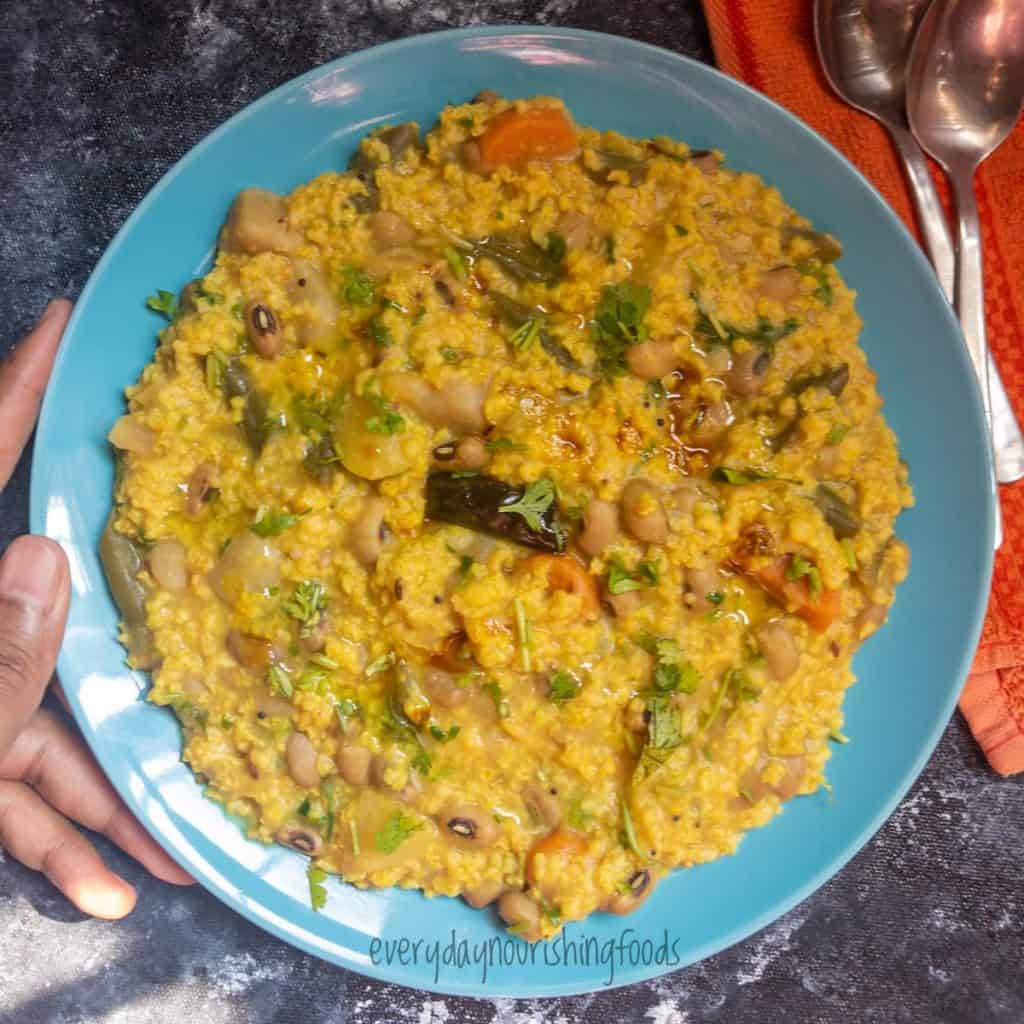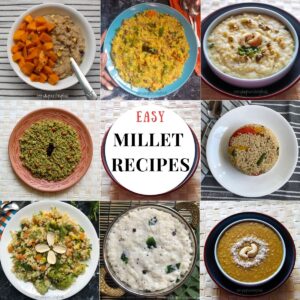Welcome to my other post from Food Tips. In this post, I will share all my easy millet recipes that you can include for your breakfast, lunch, and dinner!
Millet grain is adaptable and can easily replace grains like rice and quinoa in most recipes. Along with various millet recipes, I will also show you how to include millet in your regular recipes, just like I do.
And I invite you to try these recipes and share your experiences. I will update this post with new recipes I try in my kitchen.

Jump to:
What is Millet
Millet is an ancient grain that belongs to the grass family. It has gained much attention lately because of its amazing health benefits and culinary versatility.
Originating in Asia and Africa, millet is available in various types, such as sorghum, finger millet, foxtail millet, pearl millet, and more. Please check my detailed post on millet types to know more about each type of millet.
Easy Vegetarian Millet Recipes
Here is the list of all my favorite millet recipes you can make for breakfast, lunch, and dinner. You can make all these delicious recipes easily at home with basic ingredients. Even if you do not like millet, try these recipes, and you will surely make them again.
Millet Breakfast Recipes
Millet can be a delicious alternative to your traditional morning meals. Here are a few flavorful and wholesome millet-based breakfast recipes to start your day.
Creamy Millet Porridge

Millet Pongal

Millet sweet pongal

Millet chocolate cookies

Millet Lunch and Dinner Recipes
Here are some millet-based recipes perfect for lunch or dinner.
Millet salad

How to Cook Fluffy Millet

Millet Yogurt Rice

Instant Pot Millet

Millet Khichdi

Lemony Millet Rice

Bok Choy Millet Rice

Millet Bell Pepper Rice

Millet Bisi Bele Bath

Millet Gongura Rice (Roselle leaves Rice)

How to include millet in everyday recipes
Because of its versatility, millet can be used instead of grains like quinoa and rice in most recipes. Here are some different ways you can incorporate millet into regular recipes.
- Add it to soups and stews to make a filling meal.
- Add cooked millet to any grain salads, and it keeps you satiated.
- While making flatbreads like roti and naan bread, you can replace a small amount of regular wheat flour with millet flour.
- You can replace rice with millet in almost all recipes.
- While making a veggie burger or patty, you can use leftover millet instead of breadcrumbs. Instead of other flour, you can use millet flour to make millet cakes.
- Like overnight oats, you can make an easy breakfast with millet flakes.
- Swap quinoa or rice in grain bowls. I usually use extra millet from breakfast to make it.
- Make millet pilaf just like regular rice pilaf by replacing rice with millet.
- I use leftover cooked millet to make pudding with regular milk or dairy-free milk like coconut milk and enjoy it as a dessert.
Different forms of millet
From whole grains to flour, millet is available in different forms.
- Whole grains: Whole grain millet refers to the intact millet seeds, including pearl millet, finger millet, foxtail millet, proso millet, and others. These grains are commonly used in pilafs, porridges, or as a base for hearty salads.
- Millet Grits: Millet grits are coarsely ground millet, presenting a texture similar to coarse cornmeal. When you cook millet grits, you will get a polenta-like consistency. They serve as an excellent alternative to corn grits in recipes, used for porridge, savory dishes, or even as a coating for frying.
- Popped Millet: Popped or puffed millet is created by heating whole millet grains until they pop, resulting in small, airy, and crunchy grains. It is often used as a topping for cereals or incorporated into snack bars or granola for a delightful crunch.
- Millet Flour: Millet flour is ground from millet grains, offering a gluten-free alternative for baking. It is used in various recipes, such as flatbread, bread, pancakes, cookies, and other baked goods.
Where to buy millet
These days, you can find millet practically wherever. A well-stocked grocery stores will have various millet types (check bulk bins). They are also available at nearby natural food stores and farmer's markets. Additionally, they are available from several online retailers.
How to store millet
I use airtight jars and stainless steel containers to store whole millet grains. They remain fresh for around six months.
As with whole grains, store the flour and millet grits in a resealable bag or airtight container and keep them in a dry, cold place. I usually store the flour and grits in the refrigerator to keep them fresher for longer.
Tips for Cooking Perfect Millet Dishes
These suggestions are based on my own millet cooking experience and will help make millet recipes taste better.
- Rinse Thoroughly: Rinse the millet under cold water to remove any debris or bitterness before cooking. This step enhances its taste and texture.
- Overnight Soak: To make the fluffy millet, soak it overnight. This will also reduce the cooking time.
- Toasting: Toasting millet will make it nuttier and increase the dish's flavor.
- Millet water ratio: Proper water-to-millet ratio will provide the desired texture of the millet. Learn how to cook millet with my detailed recipe that will yield the perfect millet every time.
- Simmer Gently: After the water boils while cooking millet, turn down the heat to a simmer and cover the pot. As the millet gradually absorbs the liquid, let it simmer gently.
- Allow Resting: After cooking, keep the millet aside, covered, for a few minutes. This resting period helps to fluff up the grains and ensures even texture.
- Spice Blends: If millet feels like bland food, add some spices while cooking. Cumin, coriander, turmeric, cardamom, or cinnamon can elevate the flavors. You can also use curry powder or fresh herbs to season the cooked millet.
Frequently Asked Questions about Millet
Here are answers to some common queries about millet.
Millet is a gluten-free grain. It is an excellent option for those with gluten sensitivities or celiac disease.
No, Suji, known as semolina, rava, or cream of wheat, is not a millet. It is a coarse grain derived from wheat, mainly used in making dishes like upma, halwa, and pancakes.
Taste preference can vary, but many consider foxtail millet a mild, nutty flavor, making it a popular choice. However, taste preferences differ, so exploring various millet types can help you find the one you enjoy most.
Several millets can be great alternatives to rice based on personal preferences. Foxtail millet, little millet, and barnyard millet are commonly used as rice substitutes due to their texture, small size, and mild flavor, making them suitable for various rice-based recipes.
If you enjoyed this post, check out my Food Tips category, which has more practical cooking tips and ingredient basics to help your everyday cooking.
Have you tried this recipe? Provide your feedback by giving a star rating and/or leaving comments. And don't forget to share the recipe with others on Facebook, Instagram, Pinterest, or Twitter.
Recipe

Easy Millet recipes - Best way to cook millet
Rate this recipe by clicking the stars!
Ingredients
- 1 cup millet Raw millet
- 2 cups water
- 1 teaspoon oil
- ½ teaspoon salt optional
Instructions
- Rinse: Rinse the millet a couple of times and drain the water completely.
- Boil: Add water to the cooking pot and let it come to a boil. To this boiled water, add millet and salt. I add teaspoon of oil (Olive oil or avocado oil), which will yield fluffy millet.1 cup millet, 2 cups water, 1 teaspoon oil, ½ teaspoon salt
- Simmer: Cover the pot with the lid and cook over medium heat for 15 to 16 minutes. By now, all the water will be absorbed by the millet. If not, simmer it until the millet absorbs all liquid.
- Fluff it up: Switch off the gas, remove the pot from the heat, and let it rest for 10 minutes. After 10 minutes, fluff the millet using a fork or a spoon.
- Serve: Light and fluffy millet is ready to serve as a side dish.






Leave a Reply